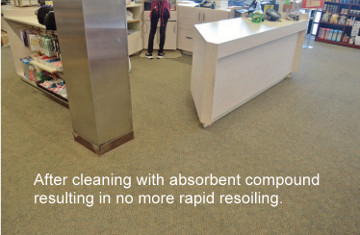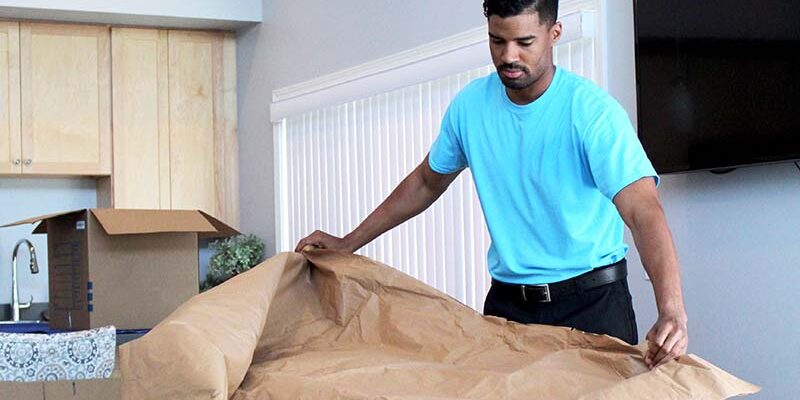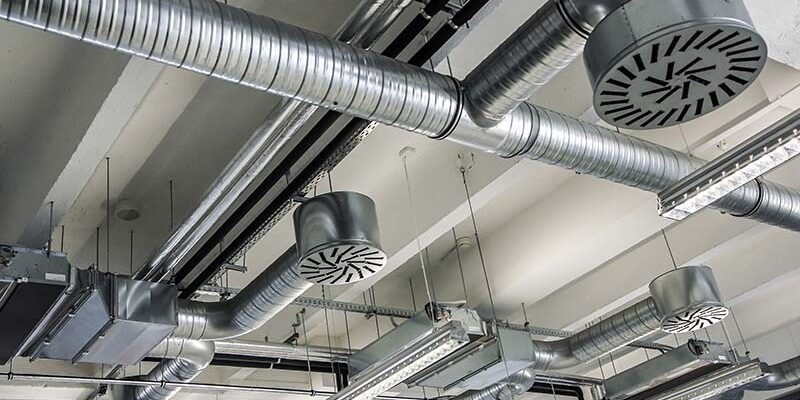Applications of Absorption

Cleaning with absorbents offers viable alternatives to using solvents. There are a number of similarities between using absorbents and solvents. By probing deeper into absorption, we can achieve many of the same results without making an unwanted vapor.
The first obstacle to overcome is not to confuse absorption with adsorption. This is an exceedingly common error.
- Absorption is an infusing inside, like an oil stain inside a fiber or like water swelling a natural fiber
- Adsorption is attraction over the surface, such as what is felt when touching the carpet.
To understand their similarities and differences, a deeper understanding is needed of two other topics, which are “states of matter” and “polarity.”
The “states of matter” common to cleaning are:
- Solids.
- Liquids.
- Gases.
There are also in-between states such as gels and mists.
Concerning polarity, every substance is either polar or non-polar or somewhere in-between. Polar substances have fixed plus and minus charges on their “ends” like batteries or magnets. Their opposite ends create self-attractions. Good examples of this are how magnets cluster together or how water forms into droplets. Similarly charged ends, on the other hand, create repulsions.
Non-polar substances have momentary opposite sides that create weaker self-attractions. Their liquids are called dry solvents and are frequently used to dissolve oil stains. A good example is chewing gum being softened by citric gels.
Tying together states of matter and polarity
Absorbents are solids. Solvents are liquids, which frequently turn into gases. Either can be polar or nonpolar.
Polar liquids are wet solvents. Non-polar liquids are dry solvents. Since they have different polarities, they do not mix together. The best example is “water and oil do not mix.”
In addition, dry solvents can only be used as spotters in carpet cleaning. Dry solvents dissolve solids like oil stains by turning them into liquids.
If a substance cannot dissolve in either a polar or non-polar solvent, it is said to be an insoluble substance. In most cases, it is an absorbent in a powder or fiber form.
Polar absorbents are hydrophilic, meaning they like water. This means it will absorb polar substances such as cotton absorbing water, but not a dry solvent.
Nonpolar absorbents are oleophilic, meaning they like oil. This means it will absorb nonpolar substances, like polyester absorbing oil, but not water. Unlike solvents, polar and nonpolar absorbents can be mixed together.
Only “dissolving” and “absorption” can remove what is inside a fiber. However, there is a significant advantage in working with absorbents; they do not become an unwanted vapor or a sticky residue. Absorbents do not need to be wet-vacuumed or evaporated.
| LIQUID | SOLID | |
| Polar | Wet solvent (water) | Hydrophilic |
| Nonpolar | Dry solvent | Oleophilic |
Two cleaning methods employ absorption:
- Absorbent pad.
- Absorbent compound.
Whereas these cleaning systems have been described as “surface cleaning methods,” in reality they can remove oily surfactants and absorbed oils that are missed by deep cleaning, non-absorbent systems. Surfactants clean only the surface of the fiber because they are “surface active agents,” thus the name.
To remove sticky residues with the absorbent pad method, one must use a “pad” that is oleophilic, such as polyester or polypropylene (olefin). Absorbent compound detergents are mixtures of hydrophilic and oleophilic materials.
Solving cleaning challenges
With this information, let’s look at a couple of specific cleaning challenges that face most carpet cleaning technicians today.
Wicking spots
In the recent past, most manufacturers of cleaning products have made absorbent spotters. A few years ago, most of them stopped because they were not selling well.
Many cleaners have relied strongly upon sub-surface extractor tools and perhaps encapsulants to solve the problem. These two things help, but sometimes more is needed.
The solution is to let the foreign substance wick into an absorbent towel or powder.
Sticky spots
A common problem in cleaning is oils that have absorbed into fibers.
Oils that are adsorbed can frequently be removed by surfactants though a process called “emulsification.” However, when oil absorbs into the fiber, the common method of removing them is to apply a dry solvent. A common result to all of these is a VOC (volatile organic compound) which is a vapor that is toxic, flammable or both.
An absorbent compound detergent or spotter could be used to achieve the same result without creating a VOC. Therefore, for those situations where VOCs are not acceptable, use an absorbent compound. It has been a common practice of some commercial maintenance companies for years.
Try it out
Many times, cleaners are unnecessarily using dry solvents when they would be better off using an absorbent of some kind.
The next time you think about grabbing a dry solvent, consider using an absorbent. If you do this, you will breathe a lot easier knowing there is not a VOC in the air.
James (Jim) B. Smith is an IICRC-approved instructor and a senior practicing inspector and part of the voting consensus of the IICRC S100 cleaning standard. His educational studies come from Texas A&M University and the University of Houston. He has been in the cleaning industry since 1975. For more information, visit his website at www.CarpetInspector.com/jbs or call (972) 334-0533 or (800) 675-4003.












